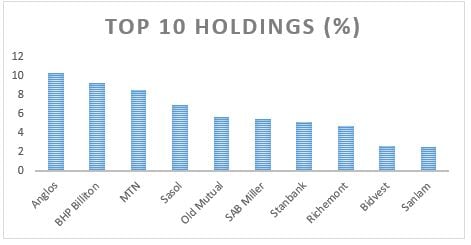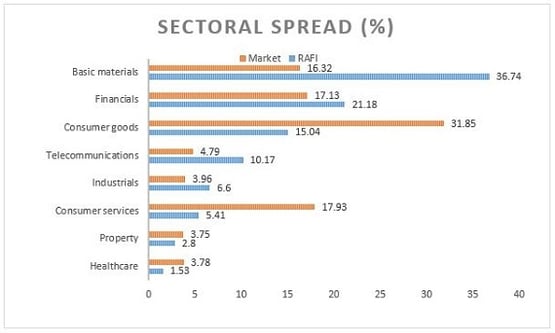ETF Tuesday: Your Top 40 Hits!
Satrix RAFI 40 Index Fund
Suitability: Most listed ETFs use some form of market capitalisation weighting to populate constituents. This means that over time, stock prices that climb the fastest end up taking up a big portion of the portfolio. This has two negative consequences – it gradually diminishes diversification, but it also means that such funds shift exposure toward recent winners and against losers. That means it can have a bias toward overvalued stocks relative to stocks that may be cheap. If you believe that it is important to eliminate this bias, as typical value investors in the mould of Warren Buffett do, there is a JSE-listed ETF made for you, the Satrix Rafi ETF.
In finance the perceived value drivers of a stock are referred to as fundamentals. Most of the stocks that wind up in this fund have a value-tilt, meaning they have low prices relative to earnings. Because value stocks tend to move somewhat differently from the market as a whole, including them in your investment mix should improve your portfolio’s diversification and return properties. For example, a strong case can be made for a fundamentals-based weighting approach following the US tech stocks crash in the early 2000s, where investors lost big after buying up tech companies that had abnormally high prices relative to earnings and poor cash metrics.
The Satrix Rafi ETF is based on 40 JSE-listed companies with the best metrics in four aspects: sales; cash flow; book value; and dividend. This ETF provides low-cost access to 40 value companies in one transaction.
What it does: It is designed to replicate the performance of the FTSE/JSE Rafi 40 index. That index represents the 40 JSE-listed stocks that have the best fundamental metrics in terms of sales, cash flow, book value and dividend. The Satrix RAFI is a total return funds, which means that all dividends are reinvested in the portfolio. Each metric gets an equal weighting.
Advantages: Implicitly the fund assumes that stocks with high relative price are overvalued, thus it reduces over-exposure to potentially overvalued equities.
Disadvantages: Conversely, it potentially excludes high growth counters, because they usually have high price relative to the factors considered in weighting this ETF, and this limits the portfolio’s growth potential.
Top holdings: The top 10 holdings of this fund take up 61% of the fund. It is interesting to note that its top holding, Anglo, has fallen out of favour with the market largely because of depressed commodity prices. In contrast, the top holding of many market cap-weighted indices, Naspers, is loved by the market because of its exciting prospects through its interests in Tencent, a Chinese tech company. In this ETF Naspers doesn’t even make the top 10.
Risk: This is a pure equities investment, so the performance is likely to be volatile.
Fees: For the year to end-March, 1.06% of the average net asset value of the portfolio was incurred as charges, levies and fees related to the management of the portfolio.


Historical performance: The fund’s performance depends on how you invest – through a single lump-sum payment or regular payments. The table below reflects the fund’s historical annualised returns for a lump-sum investment.


Fundamental view: Compared with market cap-based funds, the Rafi 40 has top holdings in sectors or companies that are generally out of favour with investors. It is overly exposed to mining companies compared with market cap-weighted funds. That has been a good position for the year to date, in which mining companies have seen a strong price recovery. Also, its construction methodology is based on history, unlike the market cap approach which somewhat captures investors’ forward expectations. Therefore, risk-return characteristics of the Rafi are somewhat different from the market. As such, an investor could benefit by establishing a position in the Rafi fund as a satellite to a core portfolio, if there is conviction that a recovery in these unloved sectors is in the offing.
This is a pure equity fund with significant SA exposure although some of its constituents have huge international or export businesses. SA’s economy is struggling to grow, which will suppress the fund’s returns. However, earnings from the fund’s international exposures should help its performance, including a kicker from translated earnings given the weak rand.
Alternatives: There are no direct peers.
BACKGROUND: Exchange traded funds (ETFs)
Exchange Traded Funds (ETFs) are passively managed investment funds that track the performance of a basket of pre-determined assets (in this case, industrial companies). They are traded the same way as shares and the main difference is that whereas one share gives exposure to one company, an ETF gives exposure to more than one company in a single transaction. ETFs can be traded through your broker the same way as shares, say, on the EasyEquities platform. In addition, it qualifies for the tax-free savings account, where both capital and income gains accumulate tax free.
Risk: This is a pure equities investment, so the performance is likely to be volatile. Investment in this fund exposes you to a number of risks including, general market risks, exchange rate risks, interest rate risks, inflationary risks, liquidity risks and legal and regulatory risks.
Fees: For the year to end-March, 0.86% of the average net asset value of the portfolio was incurred as charges, levies and fees related to the management of the portfolio. While this is slightly elevated compared with most local equity ETFs, it is far lower than what one would incur using other means of gaining offshore exposure.
Benefits of ETFs
- Gain instant exposure to various underlying shares in one transaction
- They diversify risk because a single ETF holds various shares
- They are cost-effective
- They are liquid – it is usually easy to find a buyer or seller and they trade just like shares
- High transparency through daily published index constituents
You can check out other ETF Tuesday posts here.
Disclaimer
This research report was issued by Intellidex (Pty) Ltd. Intellidex aims to deliver impartial and objective assessments of securities, companies or other subjects. This document is issued for information purposes only and is not an offer to purchase or sell investments or related financial instruments. Individuals should undertake their own analysis and/or seek professional advice based on their specific needs before purchasing or selling investments. The information contained in this report is based on sources that Intellidex believes to be reliable, but Intellidex makes no representations or warranties regarding the completeness, accuracy or reliability of any information, facts, estimates, forecasts or opinions contained in this document. The information, opinions, estimates, assumptions, target prices and forecasts could change at any time without prior notice. Intellidex is under no obligation to inform any recipient of this document of any such changes. Intellidex, its directors, officers, staff, agents or associates shall have no liability for any loss or damage of any nature arising from the use of this document.
Remuneration
The opinions or recommendations contained in this report represent the true views of the analyst(s) responsible for preparing the report. The analyst’s remuneration is not affected by the opinions or recommendations contained in this report, although his/her remuneration may be affected by the overall quality of their research, feedback from clients and the financial performance of Intellidex (Pty) Ltd.
Intellidex staff may hold positions in financial instruments or derivatives thereof which are discussed in this document. Trades by staff are subject to Intellidex’s code of conduct which can be obtained by emailing mail@intellidex.coza.
Intellidex may also have, or be seeking to have, a consulting or other professional relationship with the companies mentioned in this report.
Subscribe To Our Research Portal
Search all research
Let Us Help You, Help Yourself
From how-to’s to whos-whos you’ll find a bunch of interesting and helpful stuff in our collection of videos. Our knowledge base is jam packed with answers to all the questions you can think of.
